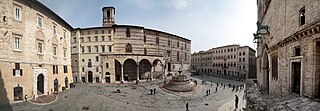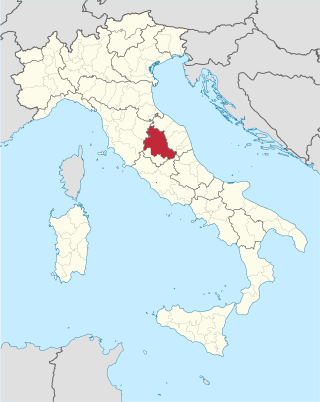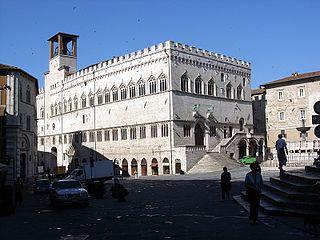Characteristics
Built from 1716 to 1724 by an unknown architect, the traditional attribution to Pietro Carattoli it's not likely, because the artist from Perugia in 1716 was barely 13 years old.
The references to sixteenth Tuscan style and coeval Roman palaces are evident. The architecture with a sober compositional order is scanned by two orders of ledges and three of windows.
On the noble floor curved gables alternate with triangular ones in travertine. The palace is adorned with 2 large portals, one opens on Corso Vannucci, the other on Piazza Italia. Both present 2 columns in travertine surmounted by a balcony. The inside was richly decorated between 1745 and 1750 by the best exponents of the artistic culture of Perugia at the time, coordinated by Pietro Carattoli; among which: Francesco Appiani, Anton Maria Garbi, Giuseppe Brizi, Giacinto Boccanera and Nicola Giuli.
Pietro Carattoli directed the works of wall decorations and decided the subject to represent.
Very interesting is the main floor, with suggestive perspective shots and mythological subjects. In the Hall of honor, above the magnificent wooden gallery, Francesco Appiani painted “Giove fulminante il cocchio dell’Orgoglio” (Jupiter hitting with lightnings Pride's Chaise). Even the chapel of the palace is entirely decorated with stuccoes and paintings framed in illusionistic architectural perspective. Over the altar cell there is the “Incoronazione della Vergine”(Coronation of the Virgin) by Francesco Appiani.
The “Sala del Caminetto”, decorated by Carattoli and Giacinto Boccanera, can be considered the most evocative as extreme example of the bold architectonical perspective present in the palace.
In the 19th century it was sold by Pierluigi Donini to the City of Perugia that used it as representative seat; the Austrian Prince of Klemens von Metternich with his chancellery was here received in 1819. Before hosting the Regional Council offices, the palace was the seat of the Faculty of Letters and Philosophy of the University of Perugia. [1]
The permanent collection of Salvatore Fiume can here be seen; Salvatore Fiume was a Sicilian artist who described episodes and characters of Umbria history. Bruno Buitoni, the owner of IBP Industries who commissioned the work, gave it as a gift to the Umbria Region. [2]
It is rather certain, from archival documents, that the palace stands on a pre-existent Roman cistern and a paleo Christian hypogeum, even if the recovered material got lost.

Perugia is the capital city of Umbria in central Italy, crossed by the River Tiber, and of the province of Perugia. The city is located about 164 km (102 mi) north of Rome and 148 km (92 mi) southeast of Florence. It covers a high hilltop and part of the valleys around the area. The region of Umbria is bordered by Tuscany, Lazio, and Marche.
Assisi is a town and comune of Italy in the Province of Perugia in the Umbria region, on the western flank of Monte Subasio.

The Province of Perugia is the larger of the two provinces in the Umbria region of Italy, comprising two-thirds of both the area and population of the region. Its capital is the city of Perugia. The province covered all of Umbria until 1927, when the province of Terni was carved out of its southern third. The province of Perugia has an area of 6,334 km² covering two-thirds of Umbria, and a total population of about 660,000. There are 59 comunes in the province. The province has numerous tourist attractions, especially artistic and historical ones, and is home to the Lake Trasimeno, the largest lake of Central Italy. It is historically the ancestral origin of the Umbri, while later it was a Roman province and then part of the Papal States until the late 19th century.

Palazzo Pamphilj, also spelled Palazzo Pamphili, is a palace facing onto the Piazza Navona in Rome, Italy. It was built between 1644 and 1650.

The Palazzo Barberini is a 17th-century palace in Rome, facing the Piazza Barberini in Rione Trevi. Today, it houses the Galleria Nazionale d'Arte Antica, the main national collection of older paintings in Rome.

Marcantonio Franceschini was an Italian painter of the Baroque period, active mostly in his native Bologna. He was the father and teacher of Giacomo Franceschini.

The basilica diSan Pietro is a Catholic basilica and abbey in the Italian city of Perugia.

The Chigi Palace is a palace and former noble residence in Rome which is the seat of the Council of Ministers and the official residence of the Prime Minister of Italy. Since 22 October 2022, the tenant of the Chigi Palace has been Prime Minister Giorgia Meloni, although she doesn't live in the building. It is located in the Piazza Colonna, next to Palazzo Montecitorio, seat of the Chamber of Deputies.

Perugia Cathedral is a Roman Catholic cathedral in Perugia, Umbria, central Italy, dedicated to Saint Lawrence. Formerly the seat of the bishops and archbishops of Perugia, it has been since 1986 the archiepiscopal seat of the Archdiocese of Perugia-Città della Pieve.

The Palazzo dei Priori or comunale is one of the best examples in Italy of a public palace from the communal era. It is located in the central Piazza IV Novembre in Perugia, Umbria. It extends along Corso Vannucci up to Via Boncambi. It still houses part of the municipality, and, on the third floor, the Galleria Nazionale dell'Umbria. It takes its name from the Priori, the highest political authority governing the city in the medieval era.

The Galleria Nazionale dell'Umbria the Italian national paintings collection of Umbria, housed in the Palazzo dei Priori, Perugia, in central Italy. Located on the upper floors of the Palazzo dei Priori, the exhibition spaces occupy two floors and the collection comprises the greatest representation of the Umbrian School of painting, ranging from the 13th to the 19th century, strongest in the fourteenth through sixteenth centuries. The collection is presented in 40 exhibition rooms in the Palazzo. On the second floor of the Gallery, there is an exhibition space for temporary collections, changed several times a year.

Palazzo Aragona Gonzaga, also known as Palazzo Negroni, is a sixteenth-century palace in Rome, Italy. It was once the residence of Cardinal Scipione Gonzaga. During that time his cousin Luigi Gonzaga also lived there, as did the poet Torquato Tasso from 1587 to 1590. In the nineteenth century it belonged to the Galitzin family, and so is also known as Palazzo Galitzin.

Palazzo Mezzanotte, also known as Palazzo delle Borse is a 20th-century building of Milan, Italy, and the seat of the Italian stock exchange. It is located in Piazza Affari, the city square after which the Italian stock exchange itself is nicknamed. The name "Palazzo Mezzanotte" is a reference to Paolo Mezzanotte, the architect who designed the building.

Pietro Carattoli was an Italian painter of quadratura. He also made some smale scale architectural designs, such as the portal of the Cathedral of Perugia.

The Palazzo dei Consoli is a Gothic architecture, civic building in the historic center of Gubbio, region of Umbria, Italy. Construction took place during 1332–1349 under design by Angelo da Orvieto; the palace was built on a large platform built against the hillside and looming over the town below.
Giacinto Boccanera (1666-1746) was an Italian painter.

Piazza d'Aracoeli is a square of Rome (Italy), placed at the base of the Capitoline Hill, in the Rione X Campitelli.
Civitella d'Arna is a frazione of the comune (municipality) of Perugia in central Italy, and the Ancient city and former bishopric Arna, which remains a Latin Catholic titular see.

Palazzo Cesi-Armellini, sometimes known plainly as Palazzo Cesi, is a late Renaissance building in Rome. It is considered important for historical and architectural reasons. The palace, which should not be confused with Palazzo Cesi-Gaddi, Palazzo Muti-Cesi, or the destroyed Palazzo Cesi, placed also in Borgo near the southern Colonnade of St. Peter's square, is one of the few Renaissance buildings of the rione Borgo to have survived the destruction of the central part of the neighborhood due to the 20th century construction of Via della Conciliazione, the avenue leading to St. Peter's Basilica. Today, it is owned by the Society of the Divine Savior and part of it is used as their motherhouse.

The Palazzo della Provincia e della Prefettura is a public palace of Perugia built over the ruin of the Rocca Paolina.


















